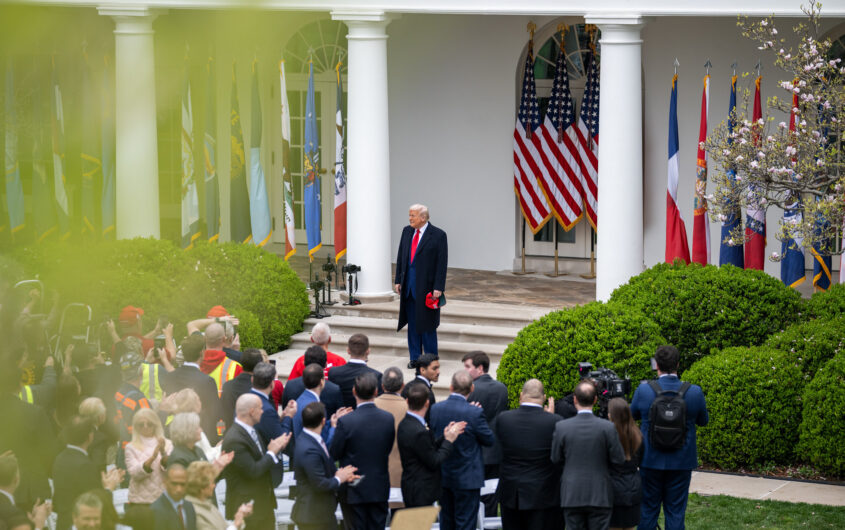
The White House via Flickr
Trade Policy: Is It Foreign or Domestic?

Peter S. Rashish
Vice President; Director, Geoeconomics Program
Peter S. Rashish, who counts over 30 years of experience counseling corporations, think tanks, foundations, and international organizations on transatlantic trade and economic strategy, is Vice President and Director of the Geoeconomics Program at AICGS. He also writes The Wider Atlantic blog.
Mr. Rashish has served as Vice President for Europe and Eurasia at the U.S. Chamber of Commerce, where he spearheaded the Chamber’s advocacy ahead of the launch of the Transatlantic Trade and Investment Partnership. Previously, Mr. Rashish was a Senior Advisor for Europe at McLarty Associates, Executive Vice President of the European Institute, and a staff member and consultant at the International Energy Agency, the World Bank, UN Trade and Development, the Atlantic Council, the Bertelsmann Foundation, and the German Marshall Fund.
Mr. Rashish has testified before the House Financial Services Subcommittee on International Monetary Policy and Trade and the House Foreign Affairs Subcommittee on Europe and Eurasia and has advised three U.S. presidential campaigns. He has been a featured speaker at the Munich Security Conference, the Aspen Ideas Festival, and the European Forum Alpbach and is a member of the Board of Directors of the Jean Monnet Institute in Paris and a Senior Advisor to the European Policy Centre in Brussels. His commentaries have been published in The New York Times, the Financial Times, The Wall Street Journal, Foreign Policy, and The National Interest, and he has appeared on PBS, CNBC, CNN, NPR, and the BBC.
He earned a BA from Harvard College and an MPhil in international relations from Oxford University. He speaks French, German, Italian, and Spanish.
On April 2, President Trump announced a major action “Regulating Imports with a Reciprocal Tariff” as a response to “large and persistent” U.S. trade deficits that the administration believes are caused by higher trade duties and other barriers abroad. Under this measure on what the president has called “Liberation Day,” a minimum 10 percent tariff will be imposed on all countries, while roughly sixty U.S. trading partners will face rates up to 50 percent. The goal is to equalize the tariff paid on U.S. imports and exports for a range of manufactured products. By doing so, the White House hopes to incentivize investment in the United States as a location for production and job creation.
The idea that erecting a tariff wall will lead companies to shift their operations to the United States is a contested assertion. So is the notion that U.S. trade deficits are primarily caused by foreign trade barriers. There are several other domestic and international factors that explain why the United States has maintained a global trade (or current account) deficit since the late 1970s: the role of the dollar as an international reserve currency, U.S. consumer preferences, U.S. fiscal policies, and the country’s low savings rate.
What about imbalanced trade with individual countries? It is true that some, like China, heavily subsidize their exports in certain sectors (electric vehicles are an example) in a way that leads to an unfair result. But in most cases, it is market forces that cause the United States to import or export greater or lesser quantities of goods and services with another country.
If reducing the ability of China to leverage U.S. trade dependencies for geopolitical purposes remains a concern, weakening Vietnam, Cambodia, Bangladesh, and other alternative producers is counterproductive.
The U.S. administration’s dramatic step this week raises another issue: should trade policy be seen as a tool of domestic or foreign policy? By levying tariffs on a wide range of trading partners—some of whom, like Japan, are U.S. treaty allies—the White House is asserting the primacy of domestic objectives. But in doing so, it risks sacrificing equally important foreign policy goals that in the long run could also undermine U.S. prosperity.
Take the very high 46 percent tariff announced on Vietnam. It is true that some exports from that country to the United States have been from Chinese factories that have moved across the border to avoid already high U.S. tariffs on China. But more and more, Vietnam’s exports are produced by home-grown or even U.S.-owned companies. If reducing the ability of China to leverage U.S. trade dependencies for geopolitical purposes remains a Trump administration concern, weakening Vietnam, Cambodia, Bangladesh, and other alternative producers is counterproductive.
In the end, it is a false dichotomy to ask if trade should be considered domestic or foreign policy. Especially in an era when the global economy is becoming an arena of geopolitical tension, the two areas of policy need to be carefully integrated.







